In Episode 30, we’re talking about the ingredient lists of many popular Halloween candies and why you probably want to avoid most of them. All with a little help from my good buddy, Beetlejuice!
For show notes, pictures, transcript, and more, go to Wise-Eats.com/Episode30
Episode Timestamps
- Wise-Eats.com/Episode30 for show notes, YouTube video, and more! (0:00)
- It’s a Halloween candy extravaganza featuring Beetlejuice! (0:15)
- My history with candy, former addiction, and today’s habits (0:30)
- Halloween candy fun facts (1:30)
- Parents stealing candy from their kids! (2:00)
- Negative health effects of candy and ingredients to watch out for (2:15)
- Going over the ingredient lists of many popular candies (3:00)
- Listing the worst ingredients found in popular candy (3:00)
- Reese’s Peanut Butter Cup Review (3:15)
- The problem with chocolate in candy (4:00)
- Dairy, soy lecithin, PGPR (4:30)
- Peanuts, Dextrose, Salt, TBHQ (5:30)
- Citric acid aka GLUTEN (6:30)
- Snickers Candy Bar Review (6:45)
- Palm Oil, egg whites, artificial flavors (7:00)
- Twix Review (8:15)
- Enriched wheat flour (8:50)
- Modified corn starch, baking soda (9:15)
- Butterfinger (9:50)
- Vegetable oil, annatto color (10:00)
- Find out why I avoid natural flavors at Wise-Eats.com/NaturalFlavors (10:15)
- Hershey’s w/ Almonds (10:30)
- PGPR, chopped almonds, sunflower oil (10:45)
- Kit Kat (11:15)
- Vanillin (11:30)
- Peanut M&M’s (11:45)
- Cornstarch, Dextrin, Artificial Coloring (12:00)
- Skittles (12:45)
- Hydrogenated palm kernel oil (12:50)
- Sodium citrate, blue lake 1, yellow 6, red 40, yellow 5, blue 1, artificial colors (13:20)
- Carnauba wax (13:50)
- Sour Patch Kids, Swedish Fish, Starburst (14:00)
- Healthy alternatives to candy (14:15)
- Candy contributes to emotional well-being? (15:00)
- Be accountable about the things you’re putting in your body and have a Happy Halloween! (15:15)
- Wise-Eats.com/Episode30 for show notes, YouTube video, pictures, transcript, and more!
- Beetlejuice Blooper Reel! (16:00)
- Website Link: Wise-Eats.com/Episode30
- YouTube Video: https://youtu.be/8owBY1bosEU
- Audio Only Link: https://traffic.libsyn.com/secure/wiseeats/Episode_30.mp3
- Podcast Webpage: Wise-Eats.com/Podcast
- Instagram: @weswisefitness
- E-Mail: wiseeatspodcast@gmail.com
- Facebook.com/wiseeatspodcast
Recipes Mentioned in This Episode:
- Coco Cups: Wise-Eats.com/Coco
- Piledriver Protein Pudding: Wise-Eats.com/Piledriver
- Frozen Banana Chocolate Pudding: Wise-Eats.com/ProteinPudding
- Fully Charged Chocolate Protein Smoothie: Wise-Eats.com/FullyCharged
- Complete Recipe List: Wise-Eats.com/Recipes
Articles/Brands/Products Mentioned in This Episode:
- Reese’s Peanut Butter Cup
- Snickers
- Kit Kat
- Twix
- Butterfinger
- Peanut M&M’s
- Skittles
- Swedish Fish
- Starburst
- Sour Patch Kids
- Beetlejuice (1988)
- Jump In De Line (Shake Senora) (Karaoke Instrumental Track) (In the Style of Harry Belafonte)
- Beetlejuice – Main Title
Website Design Thank You: DoeringDesign.com
Logo Design Thank You’s: @this_show, MGSignsDesign.com
Editing Animations Thank You: Darin Roberts aka Misteredit1 on YouTube
The Wise Eats Podcast is written, filmed, edited, and produced by Wesley Wise, and shared by YOU. Your support is greatly appreciated!
Submit questions, comments, feedback to WiseEatsPodcast@gmail.com or to @weswisefitness on Instagram. Thanks for watching, listening, reviewing, liking, subscribing, and sharing. Be good to yourself, be good to others, and make wise choices!
Intro
Well, hello again wise guys and gals, and welcome to another delectable edition of the Wise Eats Podcast. I’m your host, certified fitness coach and former candy addict Wes Wise, and I’ve got a tasty episode for you today, because we’re talking about one of the best parts about Halloween: CANDY. Candy used to be my favorite part of Halloween. I LIVED for candy for nearly the first 25 years of my life.
Just being honest, these days, I don’t even touch candy anymore. We don’t keep it in the house. When I see the candy jar at work or at a friend’s house, I don’t touch it or even think about it. I basically pretend like it doesn’t exist because it’s not even food to me. But I know many of you still want to enjoy candy, so I’m not attempting to ruin your Halloween, just want you to be informed, so let’s get into it. It’s time to wise up.
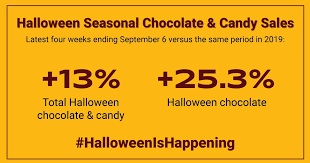
Halloween Candy Stats
- The Halloween season (i.e., the eight weeks leading up to October 31) accounts for about $4.6 billion in confectionery sales each year (New survey, 2020).
- Also, COVID hasn’t hurt candy sales much, as total Halloween chocolate and candy sales are up 13% over this same time period last year (Kiner, 2020).
- 79 percent of parents take Halloween candy from their kids after they go trick-or-treating. (New survey, 2020).
Halloween Candy Health Effects
The problem with that is, most mainstream candies are really bad for you. They’re loaded with added sugar, artificial ingredients, non-organic dairy, gluten, corn, and soy. They contain tons of empty calories and virtually zero nutrients. They also rot your teeth! I spent way too much time at the dentist a as a result of my sugar addiction early in life. I had at least 4 cavities, a root canal, and now have two dental implants to show for my poor lifestyle habits. Not cool!
So, before you go diving into that pillowcase full of candy, I want to share the ingredient lists of some of the most popular candies out there and why you might want to avoid them.
Toxic Candy Ingredients to Watch Out For
These are the most common ingredients you’ll find in common candies that you want to avoid:
- High Fructose Corn Syrup and Corn Syrup
- Hydrogenated Oils
- Soy
- Artificial Colors, Flavors, and Sweeteners
- Preservatives
- Gluten (May be listed as maltodextrin, modified food starch, caramel coloring or flavoring, citric acid, and natural flavorings)
- Non-organic Dairy – including skim milk, milkfat, and lactose. May contain growth hormones.
Popular Halloween Candy Ingredient Lists
Ok, so what about some of our favorite candies? Are they all really that bad? I wanted to take a look for myself at some of my all-time favorites and dive deeper into the ingredient lists, so here we go:
Recommended Daily Allowance for Sugar
- Men: No more than 36g of added sugar per day
- Women: No more than 25g of added sugar per day (How much, 2020).
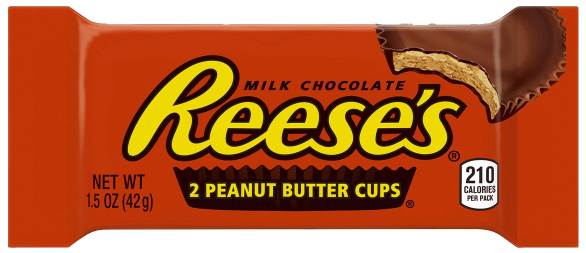
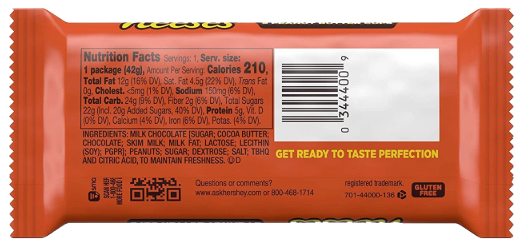
Reese Peanut Butter Cups
- Sugar – The first problem here is the added sugar with no nutritional benefit. 11g of sugar per peanut butter cup, which contributes to weight gain, diabetes, and increases cravings. Two peanut butter cups equal almost your entire day of sugar.
- Cocoa Butter – I’m ok with cocoa butter, preferably organic.
- Chocolate – Another big problem with these mainstream candies is that they’re a very low-quality chocolate. Milk chocolate is not nutrient dense like dark chocolate. If you’re enjoying chocolate, you want it to be as closes to its raw form as possible, which is raw cacao. Raw cacao is one of my favorite ingredients to have in the kitchen.
- Skim Milk – Regular or conventional milk comes from GMO cows that have been served a steady diet of GMO soy and grain. Those GMO’s are passed to the milk and meat we eat. Choose organic milk whenever possible.
- Milk Fat – Again, I’m not opposed to dairy, but if you’re lactose intolerant, this product is going to be a problem for you.
- Lactose – Again, low quality milk being used here, likely the worst of the worst.
- Soy Lecithin – This is a genetically modified emulsifier used to stabilize processed foods that I almost always avoid. I might approve of this if it we’re organic, but it’s not.
- PGPR (Polyglycerol Polyricinoleate) – Another emulsifier that increases the shelf life of products and decreases the thickness of the chocolate. One of those ingredients that’s considered “generally recognized as safe” (GRAS), but the long-term studies are not available (Are Reese, 2020).
- Peanuts – Ok, peanuts, now we’re talking! I can live with peanuts, but you can do much better with other, higher quality nuts like almonds, cashews, or walnuts.
- Dextrose – Just another form of sugar made from corn. Sugar, sugar, sugar!
- Salt – Salt is fine, just brings out the flavors. I’m a big fan of adding salt to many of my meals.
- TBHQ (Tertiary Butylhodroquinone) – Extends the shelf life of food but is also used in varnishes, lacquers, pesticides, perfumes, and cosmetics! It’s another ingredient that is “GRAS”, but conclusive studies just aren’t there (Are Reese, 2020).
- Citric Acid – One of the most common food additives in the world. Maintains freshness and adds flavor. It is naturally found in many fruits, but is also highly manufactured, especially in the case of Reese’s Cups. I won’t pass on a product specifically because of this ingredient, but it’s one to be aware of, especially in low-quality processed foods (Van De Walle, 2019).
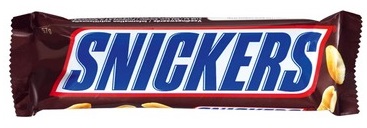
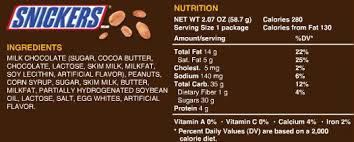
Snickers
Many common ingredients here: Sugar, cocoa butter, chocolate, milk.
- Corn Syrup – Just another highly processed form of sugar.
- Palm Oil – Highly processed vegetable oil found in close to 50% of the packaged products we find in supermarkets, from pizza, donuts, and chocolate to shampoo, toothpaste, and lipstick. It increases shelf life, adds texture and creaminess. It’s odorless and tasteless so it doesn’t affect the flavor, but it’s loaded with saturated fat and is a major driver of deforestation (8 things, 2020).
- Egg Whites – Not mad at the added protein from eggs, but again, non-organic and of the lowest quality eggs.
- Artificial Flavor – They didn’t even go with natural flavors and went straight to artificial! A huge red flag.
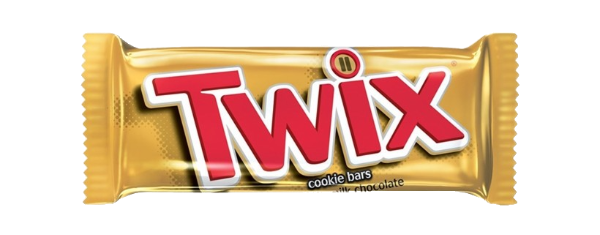

Twix
Again, common ingredients already covered, but here are a few newbies:
- PGPR – The dreaded PGPR again. When you see an ingredient that’s so long they have to make an acronym for it, you KNOW it’s bad!
- Enriched Wheat Flour – Highly processed,
stripped down flour that lacks essential nutrients like fiber. Vitamins and
minerals are stripped from the wheat during processing, so some of these
nutrients are added back in through further processing, hence the term
“enriched”. These refined carbs leave you hungry, craving more and can cause
your body to store more calories as fat (Boldt, 2020). Enriched with the following
vitamins:
- Niacin (Vitamin B3)
- Reduced Iron
- Thiamine Mononitrate (Vitamin B1)
- Riboflavin
- Folic Acid
- Modified Corn Starch – Modified to improve the texture and consistency of foods. Used as a stabilizer, thickening agent, or an emulsifier, and likely contains gluten (Sager, 2010).
- Baking Soda – Leavening agent that helps cakes and cookies more tender, moist, and fluffy (Migala, 2018). Generally safe but I wonder about what hidden chemicals could be in low-quality baking sodas.
- Artificial Flavor – You all already know I try to avoid almost every product that contains natural or artificial flavors because they’re not closely regulated and there’s no way to tell exactly what’s in them. Find out more at Wise-Eats.com/NaturalFlavors

Butterfinger
- Vegetable Oil – Highly processed oil that promotes inflammation in the body due to high omega-6 fatty acid content. We want more omega-3’s than omega-6’s (6 Foods, 2016).
- Peanut Flour – Again, I’m good with peanuts but beware of allergies and I’d prefer to see a high quality, organic peanut flour
- Annatto Color – Estimated that 70% of natural food colors are derived from annatto. Generally thought the be safe for most people (Raman, 2019).
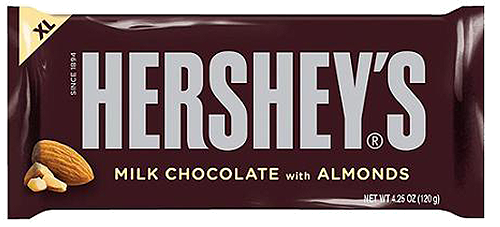
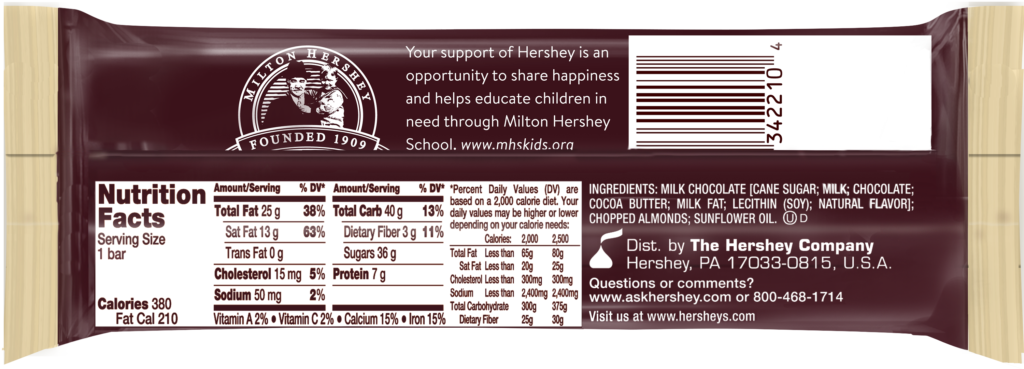
Hershey’s w/ Almonds
- This one might be the best of the bunch, but that’s not saying a whole lot. Contains chopped almonds, which is a big step up from peanuts because of their nutrient density. But this bar also contains sunflower oil, which is another vegetable oil in the same family as soybean and palm oil. Highly processed GMO oil and best to be avoided.
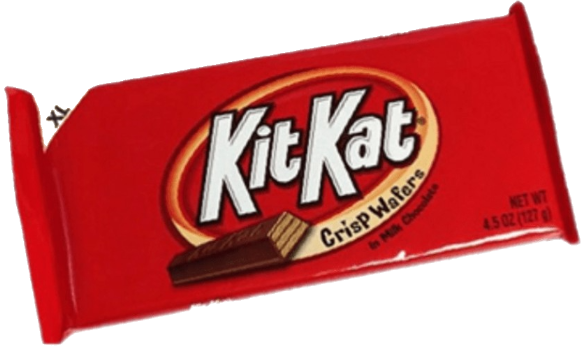
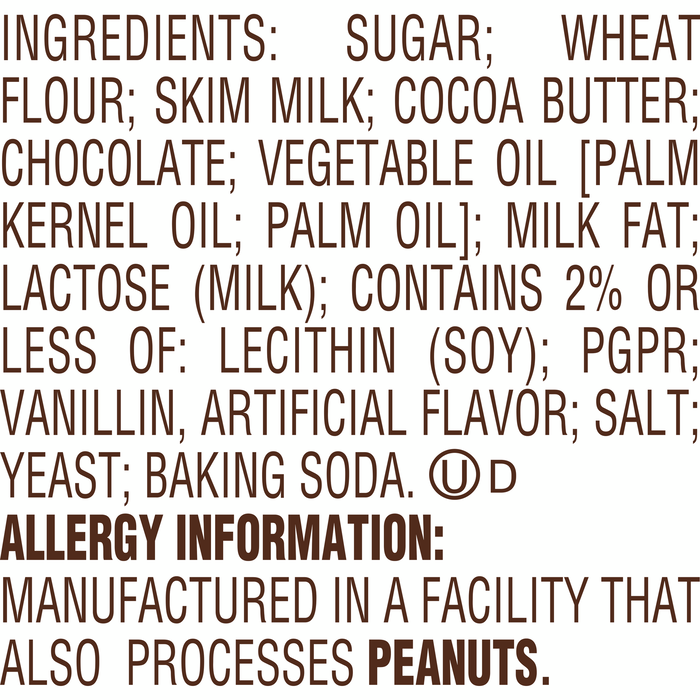
Kit Kat
This one might have the worst ingredient list of the bunch. Many of the same ingredients already covered here, but also including vanillin, which is a cheap, synthetic version of vanilla that may trigger allergic reactions, digestive disorders, and migraine headaches (The Truth, 2014).
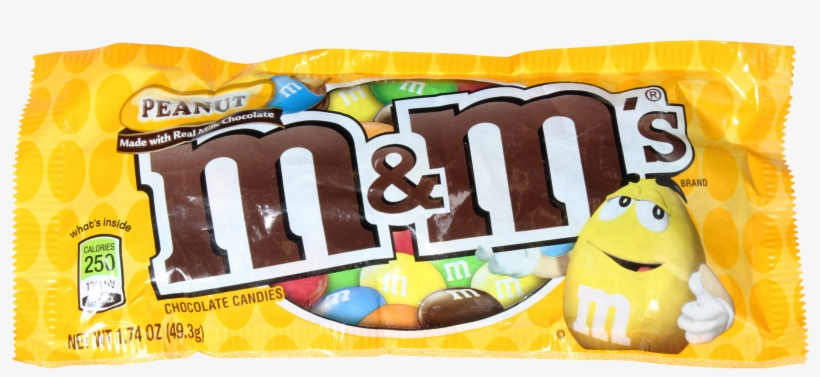
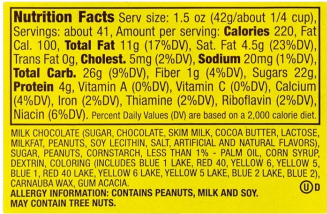
M&M’s (Peanut)
Cornstarch is a refined, fast-digesting carbohydrate. It’s used to thicken, soften, or add crispiness. It’s high in calories and low in nutrient quality. It’s high in carbs with no dietary fiber to back it up (Link, 2020).
Dextrin is a highly processed carbohydrate made from corn, tapioca, or wheat. It lacks significant nutrients and should be avoided by those with food allergies or gluten sensitivities (Adams, 2017).
Coloring (Blue 1 Lake, Red 40, Yellow 6, Yellow 5, Blue 1, Red 40 Lake, Yellow 6 Lake, Yellow 5 Lake, Blue 2 Lake, Blue 2) – These chemical substances give their artificial color. The FDA claims that these artificial dyes do not pose a significant health risk. Some studies have shown these dyes to increase the risk of allergic reactions, tumors, cancer, and hyperactivity in children, although concrete evidence is scarce. The dyes are highly controversial and have been banned in some countries (Bell, 2017). While the extensive research may not be there, I’m not taking any chances with ingredients like this.
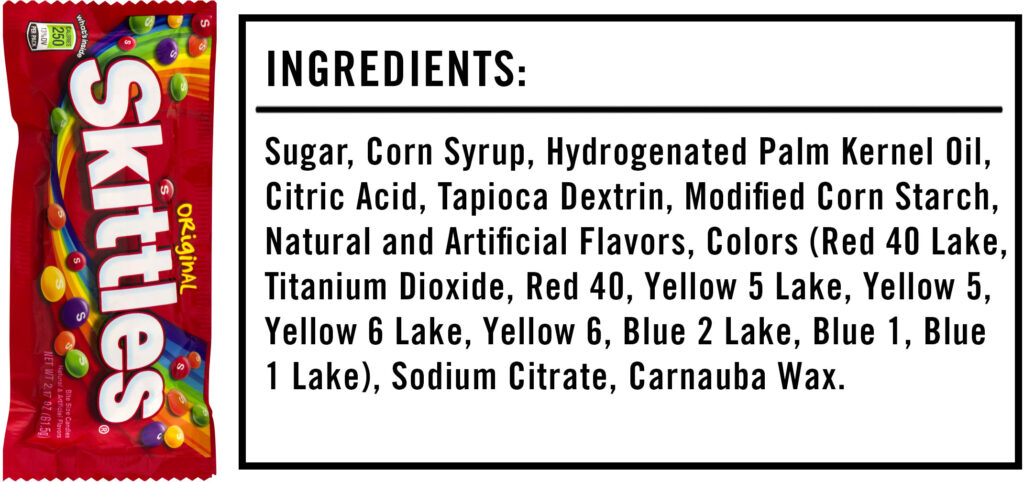
Skittles
Skittles contain a unique ingredient on this list: hydrogenated palm kernel oil. It’s high in trans fat, the worst type of fat you can eat. Trans fat raises your bad cholesterol and lowers good cholesterol, increasing the risk of heart disease.
Sodium Citrate – The sodium salt of citric acid. Used as a flavor enhancer or preservative. Can add sour or salty flavor (Volling, 2016).
Carnauba Wax – Safe in its natural form but is often blended with synthetic chemicals, making it toxic (Backe, 2017).
Oh, and look! Skittles are gluten-free! They must not be bad then, right? LOL
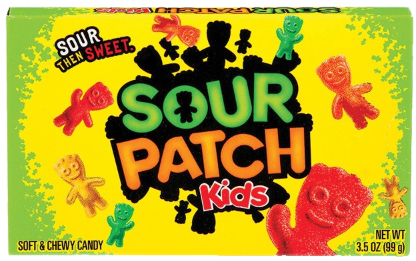
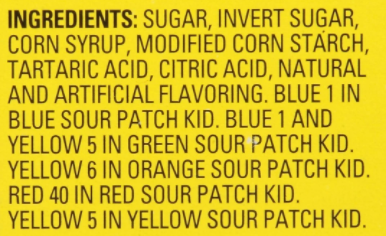
Sour Patch Kids
Invert Sugar – Nutritionally the same as table sugar and other added sweeteners. Used for its ability to retain moisture and keep a smooth texture (Carroll, 2020).
Tartaric Acid – Occurs naturally in many plants, most notably grapes. Enhances fruit flavors and stabilizes vatter systems and color. Odorless and has an acidic taste (Tartaric Acid, 2020).
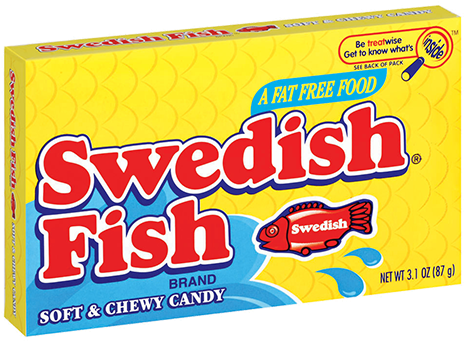
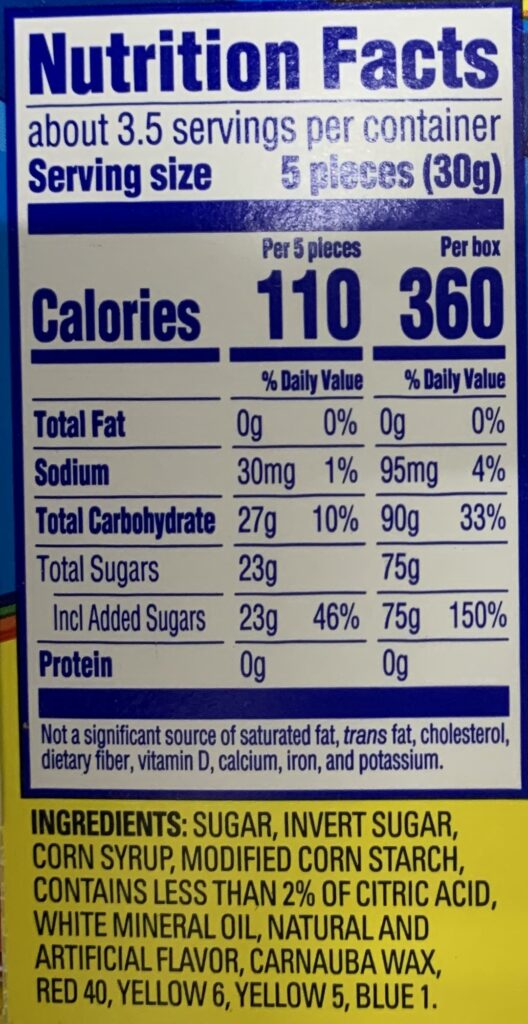
Swedish Fish
All of the colored, fruity candies are similar with their ingredient lists. This one contains white mineral oil, which I’ve never heard of. Why can’t it just be coconut oil? Why you gotta be all sneaky with the white mineral oil no one’s ever heard of?
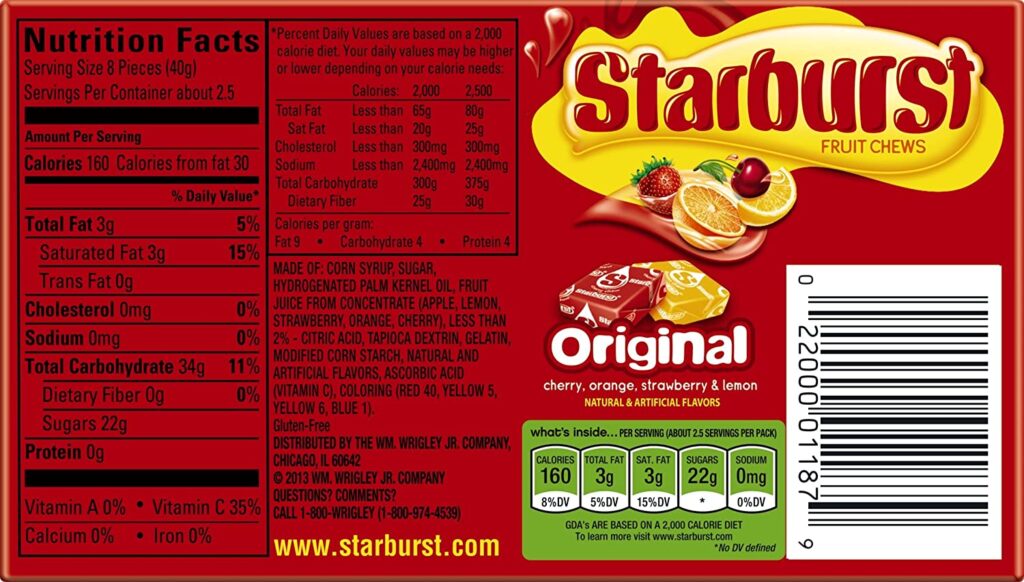
Starburst
All the same ingredients along with some apple juice from concentrate. Even if there’s a tiny little bit of nutrition in the apple juice, it’s nullified with all of the added sugar and GMO oil. Just eat an apple already!
Conclusion
The bottom line is that these popular candies are too high in calories, fat, sugar, and toxic ingredients. If I’m going the candy route, I will buy chocolate bars that are at least 70% cacao with preferably organic, short ingredient list. Usually, I’m making my own treats at home.
When I am craving chocolate or candy, I turn to a recipe with real cacao like a chocolate protein shake, some chocolate protein pudding, or the Wise Eats Coco Cups. Dark chocolate bars of at least 70% cacao are another great option.
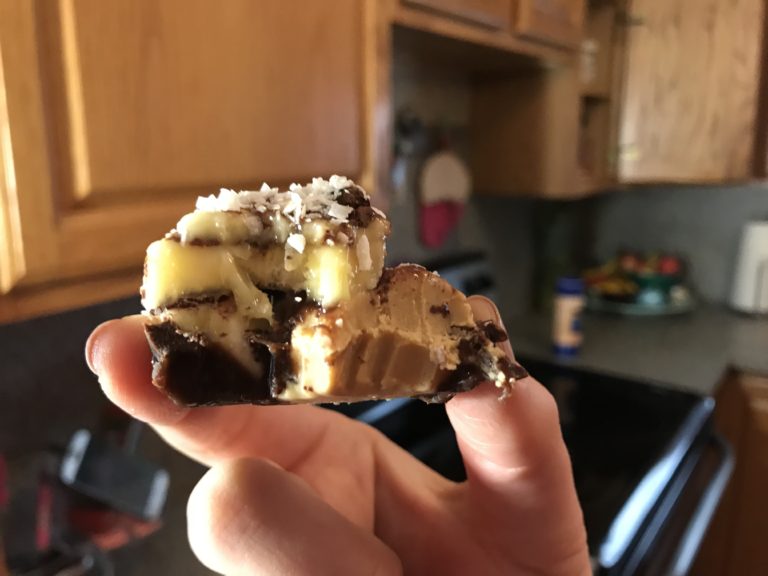
Now, just because I’m not having any Halloween candy doesn’t mean I’m hating on those that do. In fact, some folks believe that candy contributes to emotional well-being, and there’s something to be said for that! A Harris Poll’s research found that 75% of Americans believe chocolate and candy are integral to consumers’ emotional well-being (New survey, 2020).
I’m not trying to rain on anyone’s Halloween parade here, just trying to encourage all of you out there to be accountable about the things you’re putting in your body. I want you to be your highest-quality self, so only put the highest quality ingredients in your body.
Thanks for watching and listening, have a happy Halloween, and make wise choices!

References
6 foods that cause inflammation. (2016, February 20). EcoWatch. Retrieved from https://www.ecowatch.com/6-foods-that-cause-inflammation-1882175983.html
8 things to know about palm oil. (2020, January 17). World Wildlife Foundation. Retrieved from https://www.wwf.org.uk/updates/8-things-know-about-palm-oil
Adams, R. (2017, January 3). Is tapioca dextrin bad for you? Is It Bad For You? Retrieved from https://www.isitbadforyou.com/questions/is-tapioca-dextrin-bad-for-you
Are Reese’s Peanut Butter Cups bad for you? (2020, October 17). Is It Bad For You? Retrieved from https://www.isitbadforyou.com/questions/are-reeses-peanut-butter-cups-bad-for-you
Backe, C. (2017, November 17). The dangers of carnauba wax explained: Stay safe! Maple Holistics. Retrieved from https://www.mapleholistics.com/blog/dangers-carnauba-wax/
Bell, B. (2017, January 7). Food dyes: Harmless or harmful? Healthline. Retrieved from https://www.healthline.com/nutrition/food-dyes
Boldt, A. (2020, October 17). Is unbleached enriched wheat flour good for you? Livestrong. Retrieved from https://www.livestrong.com/article/482413-is-unbleached-enriched-wheat-flour-good-for-you/
Carroll, C. (2020, January 9). Invert sugar facts and benefits. Very Well Fit. Retrieved from https://www.verywellfit.com/what-you-should-know-about-invert-sugar-4163580
How much sugar is too much? (2020, October 19). American Heart Association. Retrieved from https://www.heart.org/en/healthy-living/healthy-eating/eat-smart/sugar/how-much-sugar-is-too-much
Link, R. (2020, August 28). Is cornstarch bad for you? Nutrition and health effects. Healthline. Retrieved from https://www.healthline.com/nutrition/is-cornstarch-bad-for-you
Migala, J. (2018, August 2). All about baking soda: History, surprising uses, and what it can and can’t do for your health. Everyday Health. Retrieved from https://www.everydayhealth.com/diet-nutrition/diet/baking-soda-uses-benefits-side-effects-recipes-more/
New survey data: Halloween is happening and Americans are ready to celebrate creatively and safely throughout October. (2020, August 7). National Confectioners Association. Retrieved from https://candyusa.com/news/halloween-is-happening/
Raman, R. (2019, September 10). What is annatto? Uses, benefits, and side effects. Healthline. Retrieved from
Sager, J. (2010, April 4). Is modified corn starch bad for you? Café Mom. Retrieved from https://cafemom.com/lifestyle/100756-is_modified_corn_starch_bad
Tartaric Acid. (2020, October 18). Bakerpedia. Retrieved from https://bakerpedia.com/ingredients/tartaric-acid/
The truth about vanillin. (2014, May 6). Melt Organic. Retrieved from https://meltorganic.com/2014/05/06/the-truth-about-vanillin/
Van De Walle, G. (2019, February 15). What is citric acid, and is it bad for you? Healthline. Retrieved from https://www.healthline.com/nutrition/citric-acid
Volling, J. (2016, February 25). Is sodium citrate bad for you? Is It Bad For You? Retrieved from https://www.isitbadforyou.com/questions/is-sodium-citrate-bad-for-you
